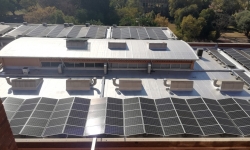Real-life experiments with solar photovoltaics realise significant cost savings
The CSIR Solar Photovoltaic Facility
The electricity generated by the solar photovoltaic (PV) plants installed at the CSIR Pretoria campus has reduced the CSIR’s electricity bill by over R14 million since 2015.

The CSIR Solar Photovoltaic Facility
The electricity generated by the solar photovoltaic (PV) plants installed at the CSIR Pretoria campus has reduced the CSIR’s electricity bill by over R14 million since 2015.
The CSIR Energy Research Centre began investing in renewable energy with the installation of solar PV systems at the start of 2015. The CSIR commissioned the solar PV system to provide a demonstration facility, leading the way towards a sustainable energy future; provide a cost saving in the form of reduced monthly electric bills; and provide a research platform to test and validate locally manufactured and assembled products in a real-world environment. The PV plants are commercially designed and built to meet a 25-year lifespan, providing a steady stream of electricity during daylight hours at costs below the prevailing tariffs, which leads to a positive net present value on the investments made in the facility.
In addition to the reduction in electricity cost, the PV plants have also aided industry collaboration. The plants attracted the attention of numerous companies that wanted to understand how the system works and what the comparative benefits were. These visits have resulted in collaborations between companies in the PV industry and the CSIR.
The solar PV plants installed at the CSIR consist of a 558 kWp ground-mounted single axis tracker, a 202-kWp ground-mounted dual axis tracker, a 250 kWp east-west fixed rooftop system on one of its buildings, a 911 kWp east-west fixed rooftop system on five additional buildings, and an additional 30 kWp ground-mounted dual axis tracker on the south side of campus.
Specifications
- The 558 kWp ground-mounted single axis tracker plant was commissioned in 2015. Its modules tilt from east to west over the course of each day to increase electricity production, compared to a fixed tilt system, and this reduces the CSIR electricity demand by 4-5%.
- The 202 kWp ground-mounted dual axis tracker plant was commissioned in 2016. The dual axis tracker system allows modules to track the sun in elevation (up/down) and azimuth (east/west), so the modules are always facing the sun directly during the day. Four additional dual axis trackers were installed in 2019, bringing the total capacity of the dual axis tracking systems to 232 kWp. The PV plants reduce the overall CSIR electricity demand by 2-3%.
- A 250 kWp east-west fixed rooftop system was commissioned in 2017. The rooftop system was designed with an east-west-facing rack and reduces the electricity demand by 2%.
- The 911 kWp east-west fixed rooftop system (Phase 1) plant was commissioned in 2019. The Phase 1 plant system was designed with east-west-facing racks at a 10 degree tilt and reduces the overall CSIR electricity demand by 7%.
Companies and organisations that are interested in collaborating with the CSIR on solar photovoltaics, can contact the CSIR.


